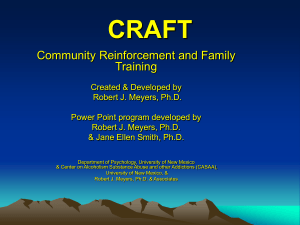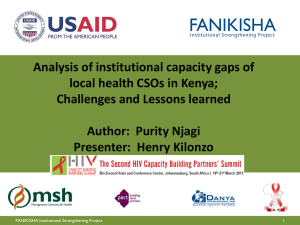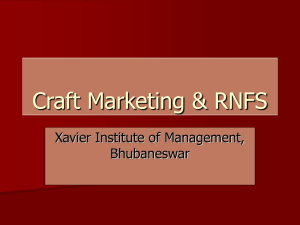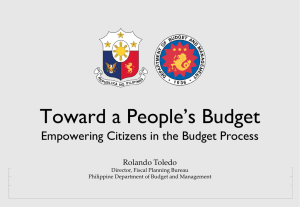CRAFT - Washington Association of Alcoholism and Addiction
advertisement
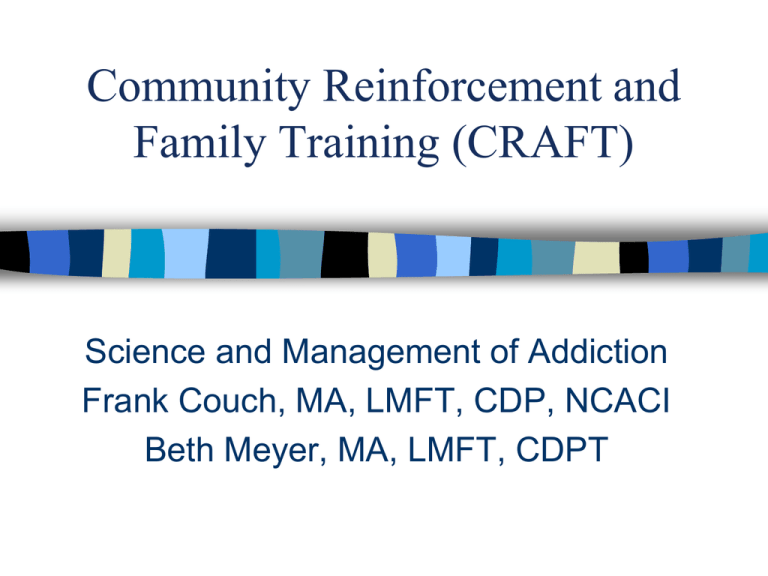
Community Reinforcement and Family Training (CRAFT) Science and Management of Addiction Frank Couch, MA, LMFT, CDP, NCACI Beth Meyer, MA, LMFT, CDPT CRAFT • This presentation is given with the permission of Dr. Robert J. Meyers, PhD, co-creator of Community Reinforcement and Family Training (CRAFT) • For more information visit: • http://robertjmeyersphd.com/ Upcoming CRAFT training! • Dr. Meyers is conducting a full 2.5 day CRAFT training in Houston Texas on June 23rd, 24th, & 25th, 2014. For further information please contact: Tammy Samour, MS, LPC, LCDC Direct: 281-407-0777 ts@aodresource.com Role of the Family • Why do families need support? • How do you or your agency currently support families? • What are challenges in working with families? • Resources working with families Community Reinforcement and Family Training • Terms • CSO – concerned significant other • IP – Identified patient (substance user) • History • Not many options for family support • Al-Anon, Johnson Institute Intervention, Changes support group, mental health counseling, nothing 12 Step Programs (Al-Anon, Nar-Anon) • Loving detachment • Acceptance of CSO’s inability to control IP’s behavior • Group support for CSO Johnson Institute Intervention • Only 29% of CSO’s complete the training • Of that 29% only 24% engage in treatment (Lipman et al 1989) Changes Parent Support Network • Peer support • “Tough Love” model • Action steps Why use CRAFT? • Because It works… • HBO Addictions series video Sisson & Azrin, 1986 Miller, Meyers, et al 1999 Kirby, et al., 1999 Meyers, Miller, et al, 1999 Meyers, Miller, et al, 2002 Waldron, et al,. 2007 14 CSOs 130 CSOs 32 CSOs 75% Anglo; 23% AA 62 CSOs 80% Hispanic 90 CSOs 88% female; 49% Hispanic 42 CSOs 48% Hispanic 48% Anglo Alcohol Alcohol 56% Cocaine 22% Opiate 37% Cocaine 35% Marijuana 16% Stimulants 8% Opiates Marijuana Cocaine Stimulants Marijuana Alcohol Randomized (CRAFT / 12-step) Randomized (CRAFT / JI / Al-Anon) Randomized (CRAFT / 12-step) Non randomized Randomized (CRAFT / AlAnon) Non-randomized 86% vs 0% CSOs better 64% vs 23% vs 13% CSOs better 74% vs 17% CSOs better 74% 67% vs 29% CSOs better 71% CSOs better CSOs better CRAFT: 3 Goals • Reduce loved one’s harmful substance use • Engage loved one into treatment • Improve the functioning of CSO • Emotional • Physical • Relationships CRAFT Program Description for the CSO • • • • Problem focused Skills based Active during sessions (role play) Active between sessions (assignments) Rapport Building Across Sessions • Always remember to: • • • • • Use empathy Reinforce attendance Stop the blaming Re-label negative behavior Emphasize family & adolescent strengths; aspects of the family life that are going well CRAFT’s Principles • Eliminate positive reinforcement for drinking and/or using behavior • Enhance positive reinforcement for nondrinking (sober) and non-using (clean) behavior Positive Reinforcement vs Enabling • Enabling: something the CSO does that increases drinking/drug using behavior or allows it to continue • CRAFT’s Positive Reinforcement: something the CSO does that increases non-drinking/non-drug using (pro-social) behavior Daily Reminder To Be Nice 1. Did you express appreciation to your adolescent today? 2. Did you compliment your adolescent today? 3. Did you give your adolescent any pleasant surprises today? 4. Did you express affection to your adolescent today? 5. Did you initiate a pleasant conversation today? 6. Did you offer to help your adolescent today? Benefits of Group Therapy: Support • • • CSOs can discuss their difficulty in trying to carry out certain CRAFT procedures CSOs can congratulate each other for making important changes CSOs can share resentment about having to work so hard in CRAFT Benefits of Group Therapy: Skills Practice Arena • Opportunities for sharing of ideas/ brainstorming • Chance to practice with “real world” cases • Opportunities for feedback from others in similar situations Benefits of Group Therapy: Modeling • Learn from successes and failures of CSOs • Hear how others manage strong reactions from their adolescents • Observe how others manage their own strong emotions • Witness examples of others continuing to try despite setbacks Group # 1: Communication Skills (Overview) (1) Offer rationale (2) Describe positive communication components (3) Generate adolescent examples (4) Role Play (5) Do a reverse role play (6) Assign homework (1) Communication Skills Rationale Why bother working on communication? • More likely to get what you want • Positive communication is “contagious” • Will open door to more satisfaction in other life areas as well (social support) • Positive communication is the foundation for other CRAFT procedures (2) Positive Communication Components: PIUS • P = say it in a positive way and say what you want as opposed to what you don’t want. • I = start with an “I” statement and express a feeling. • U = offer an understanding statement • S = share the responsibility or offer to help (3) Negative to Positive Examples: Words Matter * When you’re high, the time we spend together as a family seems like a waste. * Don’t you know I’m a complete wreck when it’s after midnight and you’re not home? I really have fun with you; we all do, when you’re clean and sober. * You never lift a ^@#%*! finger around here! I know you’re busy, but it would mean a lot to me if you could help clean out the garage Saturday. I appreciate it when you let me know in advance that you’re going to be late. (4) Role-Playing Guidelines • • • • • • • • • Acknowledge discomfort Use less difficult scenes first Get adequate description of the scene Start it for them Keep it brief (2-3 minutes) Reinforce any effort Get CSO’s reactions Offer supportive, specific feedback Repeat, repeat, repeat (5) Reverse Role-Play • Advantages: • Serves as a good starting point for a CSO who is reluctant to do a role-play • Allows therapist to model good positive communication • Helps CSO develop empathy for adolescent (6) Assign Homework • Practice Communication Skills in a conversation with adolescent over _________ issue on ____ (day/time) • Use Daily Reminder To Be Nice Remaining Sessions (2) Proven ways to help your child stay sober (3) Goal setting guidelines (4) Functional analysis part 1 (5) Functional analysis part 2 (6) Problem solving task Remaining Sessions cont’d (7) Happiness scale and personal goal setting (8) Components of supporting sober/clean behavior (9) Natural Consequences (10) Relapse prevention CRAFT: 3 Goals • Reduce loved one’s harmful substance use • Engage loved one into treatment • Improve the functioning of CSO • Emotional • Physical • Relationships Thank you!



